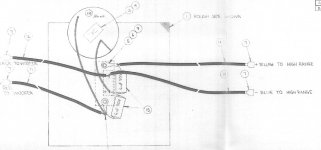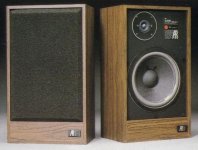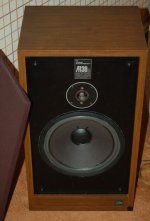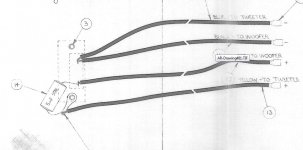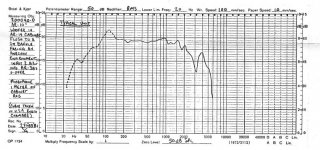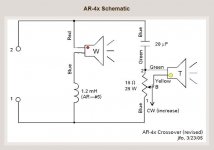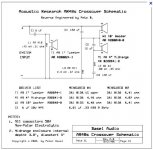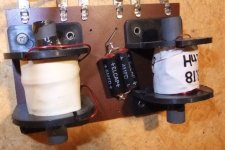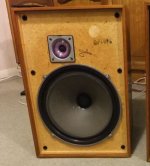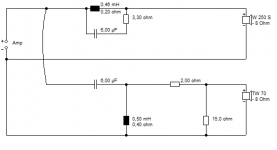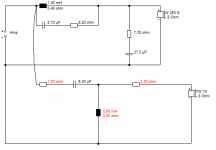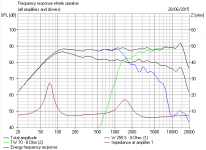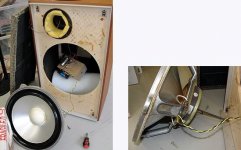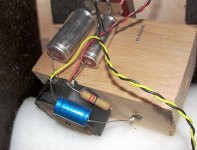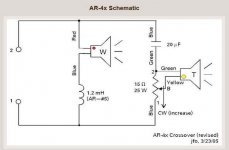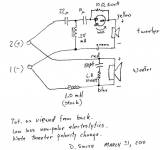Just to pick up an old thread...
Thanks for posting the diagram for the crossover of the Acoustic Research AR38s System7. Can anyone tell me what the 6uF capacitor in parallel with the woofer coil is for? My AR18s have no crossover for the woofer and rely on mechanical roll off. I'm wondering if anyone has tried modding the crossovers on the AR38s?
Thanks for posting the diagram for the crossover of the Acoustic Research AR38s System7. Can anyone tell me what the 6uF capacitor in parallel with the woofer coil is for? My AR18s have no crossover for the woofer and rely on mechanical roll off. I'm wondering if anyone has tried modding the crossovers on the AR38s?
Quite an uninteresting thread, IMO. Not much response from the original poster. 
But I can tell you are different. Acoustic Research speakers were made in a time before computer modelling. The idea was the bass had a natural rolloff, much like this SEAS CA26RE4X: H1316-08 CA26RE4X
This leads to the SEAS A26 kit:
The Madisound Speaker Store
Your Acoustic Research AR-18S speakers are not a million miles away. FWIW, 0.46 mH and 6uF on the AR-38S is a TANK which notches a peak at 3kHz and straightens out phase with any luck. I really wouldn't attempt a crossover mod on the disimmilar AR-18S to attempt the same without knowing more details.
Generally speaking, you have to replace the foam bass surrounds every ten years or so. Maybe replace the 5uF 50V non-polar capacitor. Otherwise enjoy the unique sound and liveliness.
But I can tell you are different. Acoustic Research speakers were made in a time before computer modelling. The idea was the bass had a natural rolloff, much like this SEAS CA26RE4X: H1316-08 CA26RE4X
This leads to the SEAS A26 kit:
The Madisound Speaker Store
An externally hosted image should be here but it was not working when we last tested it.
An externally hosted image should be here but it was not working when we last tested it.
Your Acoustic Research AR-18S speakers are not a million miles away. FWIW, 0.46 mH and 6uF on the AR-38S is a TANK which notches a peak at 3kHz and straightens out phase with any luck. I really wouldn't attempt a crossover mod on the disimmilar AR-18S to attempt the same without knowing more details.
Generally speaking, you have to replace the foam bass surrounds every ten years or so. Maybe replace the 5uF 50V non-polar capacitor. Otherwise enjoy the unique sound and liveliness.
Attachments
Last edited:
Hi Steve.
That's very polite describing them as "unique and lively"!
Thank you for your help. I've replaced the caps and foam surrounds in the AR18s pair and the AR38s. The tweeters in the 18s sound light, airy and clear. The exact same model tweeters in the 38s sound harsh, edgy and forward. Any ideas on how to tame them?
That's very polite describing them as "unique and lively"!
Thank you for your help. I've replaced the caps and foam surrounds in the AR18s pair and the AR38s. The tweeters in the 18s sound light, airy and clear. The exact same model tweeters in the 38s sound harsh, edgy and forward. Any ideas on how to tame them?
Graveyboat, you are an ENTHUSIAST! 
AFAIK, the AR-18S and AR-38S have the same tweeter:
http://www.classicspeakerpages.net/library/acoustic_research/special_sections/drawings/SpeakerDrawings.swf
Therefore you are actually hearing cone-breakup from the notched 10" bass of the AR-38S, here shown WITH the notch.
You might disconnect the 6uF bass notch capacitor and hope for a similar sound to the AR-18S. Notches are a double-edged sword. They increase cone output above the notch frequency. We can only hope the different 10" bass rolls off OK.
Below is the tweeter response with a simple 6uF capacitor. Crosses over at about 1.5kHz by the look of it.
I throw in the AR-4X crossover and the AR-48S just for fun. I know forum genius wolf_teeth did some work on turning the AR-4X tweeter filter to second order by adding a coil, but can't dig it up right now.
AFAIK, the AR-18S and AR-38S have the same tweeter:
http://www.classicspeakerpages.net/library/acoustic_research/special_sections/drawings/SpeakerDrawings.swf
Therefore you are actually hearing cone-breakup from the notched 10" bass of the AR-38S, here shown WITH the notch.
An externally hosted image should be here but it was not working when we last tested it.
You might disconnect the 6uF bass notch capacitor and hope for a similar sound to the AR-18S. Notches are a double-edged sword. They increase cone output above the notch frequency. We can only hope the different 10" bass rolls off OK.
Below is the tweeter response with a simple 6uF capacitor. Crosses over at about 1.5kHz by the look of it.
I throw in the AR-4X crossover and the AR-48S just for fun. I know forum genius wolf_teeth did some work on turning the AR-4X tweeter filter to second order by adding a coil, but can't dig it up right now.
Attachments
And you sir, are a Champion!
I was wanting to see the response curves for the tweeter and woofer and....here they are!
This is exactly the information i wanted, so thanks again.
The harshness does appear between 2.5K and 5K, which is where the peak is on the woofer response curve.
As an experiment with the 38s, I'm going to remove the 6uF cap from the notch filter, so I only have the coil in series as a 1st order crossover. This starts to roll off at about 2000 hz?
If that still sounds unsatisfactory, I'll try bypassing the coil on the woofer, and using a 4.7uF cap in series with the tweeter instead of 6uF, to simulate the same setup as the 18s.
I think you are correct when you suggest it is the cone breakup on the 10" woofer I am hearing.
I do like the sound of AR acoustic suspension speakers.
I was wanting to see the response curves for the tweeter and woofer and....here they are!
This is exactly the information i wanted, so thanks again.
The harshness does appear between 2.5K and 5K, which is where the peak is on the woofer response curve.
As an experiment with the 38s, I'm going to remove the 6uF cap from the notch filter, so I only have the coil in series as a 1st order crossover. This starts to roll off at about 2000 hz?
If that still sounds unsatisfactory, I'll try bypassing the coil on the woofer, and using a 4.7uF cap in series with the tweeter instead of 6uF, to simulate the same setup as the 18s.
I think you are correct when you suggest it is the cone breakup on the 10" woofer I am hearing.
I do like the sound of AR acoustic suspension speakers.
I was mistaken in identifying the SEAS drive unit used in Madisound's kit, actually it's this very smooth A26RE4 baby:
H1411-08 A26RE4
I did wonder if a 3.3uF TANK capacitor might notch the AR-38S 4kHz bass cone breakup better, but nothing worked terribly well in my sims. Losing it altogether might be best. Dunno really.
I did find some issue whether the tweeters were ferrofluid cooled in Ar-18S and AR-38S model. Again, not too sure.
Sorry, Graveyboat, It's really up to you to fix this issue. The modern approach is to lower woofer inductance and apply electrical filtering after a coil. It's a measure of AR's genius they did most of this stuff mechanically.
c.f. the high inductance SEAS CA26RE4X with the SEAS CA26RFX .
The second driver will benefit form a (1.2mH?) bafflestep coil and some electrical capacitor rolloff. The first one is fixed.
Wharfedale did a similar layout with the 10" bass Melton 2 on about 1.5kHz crossover, pictured below. Second order tweeter filter, 10uF/0.18mH along with a bass bafflestep coil I'd guess to be around 1.5mH. I liked that speaker even if the midrange was subdued.
H1411-08 A26RE4
I did wonder if a 3.3uF TANK capacitor might notch the AR-38S 4kHz bass cone breakup better, but nothing worked terribly well in my sims. Losing it altogether might be best. Dunno really.
I did find some issue whether the tweeters were ferrofluid cooled in Ar-18S and AR-38S model. Again, not too sure.
Sorry, Graveyboat, It's really up to you to fix this issue. The modern approach is to lower woofer inductance and apply electrical filtering after a coil. It's a measure of AR's genius they did most of this stuff mechanically.
c.f. the high inductance SEAS CA26RE4X with the SEAS CA26RFX .
The second driver will benefit form a (1.2mH?) bafflestep coil and some electrical capacitor rolloff. The first one is fixed.
Wharfedale did a similar layout with the 10" bass Melton 2 on about 1.5kHz crossover, pictured below. Second order tweeter filter, 10uF/0.18mH along with a bass bafflestep coil I'd guess to be around 1.5mH. I liked that speaker even if the midrange was subdued.
Attachments
Ferrofluid oil tends to dry out and turn solid (the ferrite particles) more than anything. That makes sense if you think about it, because it's working at high temperature at parties which shorten its life.
We can only hope for the best.
You don't really have many options with the AR-38S. I think harsh bass cone-breakup is always going to be the problem. But I do want to hear how it goes.
My college friends often had the lively AR-6, whereas I was more into the dull smoothness that was bextrene plastic cones or B&O electrically filtered paper cones. Nothing is perfect.
We can only hope for the best.
You don't really have many options with the AR-38S. I think harsh bass cone-breakup is always going to be the problem. But I do want to hear how it goes.
My college friends often had the lively AR-6, whereas I was more into the dull smoothness that was bextrene plastic cones or B&O electrically filtered paper cones. Nothing is perfect.
I spent some more time on the AR-38S, Graveyboat. It was tougher than I expected.
Unless you add Inductance to the circuit, which will make it bassier, you really can't do much with it.
The 6uF 3kHz Tank does a good job of rolling off the bass and aligning phase IMO. But it was deeper than necessary, and in fact only the non-polar capacitor resistance stops it being a huge pit. I found adding a 3.3R resistor made it smoother. But for all that, the mod might damage phase alignment. I don't know if AR's circuit is brilliant or stupid! Without the tank, you get quite a peak at 4kHz anyway.
There is also the possibility of doing a second order tweeter without dropping the impedance much at the top end. Say 5 ohms goes to 4...worth a go, I'd think. The tweeter ought to sound smoother. Hope that helps.
Unless you add Inductance to the circuit, which will make it bassier, you really can't do much with it.
The 6uF 3kHz Tank does a good job of rolling off the bass and aligning phase IMO. But it was deeper than necessary, and in fact only the non-polar capacitor resistance stops it being a huge pit. I found adding a 3.3R resistor made it smoother. But for all that, the mod might damage phase alignment. I don't know if AR's circuit is brilliant or stupid! Without the tank, you get quite a peak at 4kHz anyway.
There is also the possibility of doing a second order tweeter without dropping the impedance much at the top end. Say 5 ohms goes to 4...worth a go, I'd think. The tweeter ought to sound smoother. Hope that helps.
Attachments
Hi Steve. Thank you for the effort you have put in. I thought about a 2nd order for the tweeter, but decided to do this: I removed the tank cap completely (ignoring the phase shift). I then included a 1.5ohm 10watt resistor in series with the tweeter, increasing impedance, and changed the cap to 4.7uF. The caps are nice polypropylene ones made in the UK, which sound quite smooth. I also lightly doped the tweeters with some polyurethane. The crossover point shifts slightly and the tweeter is down about 2db. Resistor is inductive, but I can only hear to 12K, so not much difference there. The bass then sounded a little bloated, but this was remediated by de-coupling the speaker on stands, away from the wall. The stands just sit on the carpet, hence the decoupling. I actually think the best move was buying good quality MKP caps. The last replacement ones were stated to be polyprop, but the sound was so harsh I expect they were polyester, and poorly designed at that. So, overall I now have a quirky sound I can live with, but it was always going to be a compromise, wasn't it?
Hi guys. I just bought a set of AR38s 1981 speakers that have a little damage on the outside and the 10" woofers need refoaming. I have started the refoaming process but I was thinking if I should take this a step further and try to improve their sdesign in any way....
I have been looking online for a picture or drawings of how they are constructed and how they look on the inside so that I can know more before I make up my mind what to do, but I have not found much of any use. I am a noob in speaker refurbishing but I have a lot of professional experience in making and refurbishing furniture. So I´m good with my hands and have to tools but am not very knowledgeable about the science of making speakers.
Can you give me some advice or maybe some links that would help ?
I have been looking online for a picture or drawings of how they are constructed and how they look on the inside so that I can know more before I make up my mind what to do, but I have not found much of any use. I am a noob in speaker refurbishing but I have a lot of professional experience in making and refurbishing furniture. So I´m good with my hands and have to tools but am not very knowledgeable about the science of making speakers.
Can you give me some advice or maybe some links that would help ?
Sorry about the thread necromancy... this thread is the Web's best information source about the AR38s speaker!
I recently trash-picked a pair of AR38s. After re-foaming them they play pretty nicely. I really like that fast sealed-box bass sound. They're kinda shouty.
I hate notch filters, just on aesthetic principle. I decided to go ahead and replace the crossover with a 2nd order Bessel filter at about 1800Hz to see what happens. The steeper attenuation should help reduce the woofer's cone break-up...
To help anybody else in my situation, here's the values I (crudely) measured from my AR38s drivers:
Tweeter Impedance: 6.68 Ohms, no resonance behavior above 700Hz. Thanks, ferrofluid.
Woofer Impedance: 8 Ohms up to about 350Hz and rising at higher frequencies
Woofer DC Resistance: 6.3 Ohms
Woofer frequency where impedance is twice DC resistance: About 1250Hz
(I think this is a good stand-in for the frequency used in Rod Elliott's paragraph about Zobel network calculation at Passive Crossover Network Design)
I plan to put a variable L-Pad on the tweeter so I can tone it down if it ends up too bright. I'll post back with my impressions after the crossover replacement.
I recently trash-picked a pair of AR38s. After re-foaming them they play pretty nicely. I really like that fast sealed-box bass sound. They're kinda shouty.
I hate notch filters, just on aesthetic principle. I decided to go ahead and replace the crossover with a 2nd order Bessel filter at about 1800Hz to see what happens. The steeper attenuation should help reduce the woofer's cone break-up...
To help anybody else in my situation, here's the values I (crudely) measured from my AR38s drivers:
Tweeter Impedance: 6.68 Ohms, no resonance behavior above 700Hz. Thanks, ferrofluid.
Woofer Impedance: 8 Ohms up to about 350Hz and rising at higher frequencies
Woofer DC Resistance: 6.3 Ohms
Woofer frequency where impedance is twice DC resistance: About 1250Hz
(I think this is a good stand-in for the frequency used in Rod Elliott's paragraph about Zobel network calculation at Passive Crossover Network Design)
I plan to put a variable L-Pad on the tweeter so I can tone it down if it ends up too bright. I'll post back with my impressions after the crossover replacement.
I'd forgotten about this thread! 
FWIW, I don't think those AR cone tweeters had ferrofluid. Just impressively flat on a 6uF capacitor from 1kHz.
If it was me, these days, I'd try a circuit like below. Tweeter coil between 0.45 and 0.6mH.
10" bass likes that 3kHz notch. Leak used it in the 16 ohm sandwich speaker. The capacitors are 1,8 and 16uF. The resistor is 22 ohms. The coil will be 3mH I'd guess.
FWIW, I don't think those AR cone tweeters had ferrofluid. Just impressively flat on a 6uF capacitor from 1kHz.
If it was me, these days, I'd try a circuit like below. Tweeter coil between 0.45 and 0.6mH.
10" bass likes that 3kHz notch. Leak used it in the 16 ohm sandwich speaker. The capacitors are 1,8 and 16uF. The resistor is 22 ohms. The coil will be 3mH I'd guess.
Attachments
I can confirm that at least one of these AR tweeters has ferrofluid in it.
One of my tweeter cones had come unglued, so I partially disassembled it while re-gluing. There's ferrofluid in there -- it's old and thickened but I didn't bother to clean it out or replace it. I also didn't bother to open the other one, which was still firmly glued together.
I'll have a think about that schematic you posted. Thanks a bunch!
One of my tweeter cones had come unglued, so I partially disassembled it while re-gluing. There's ferrofluid in there -- it's old and thickened but I didn't bother to clean it out or replace it. I also didn't bother to open the other one, which was still firmly glued together.
I'll have a think about that schematic you posted. Thanks a bunch!
Last edited:
Hmm, dried out ferrofluid is NOT GOOD really. 
It's just lumpy brown ferric oxide gunge that sits in the gap spoiling the sound after the oil has dried out. Bit like the magnetic stuff they used to make audiocassettes out of.
The phenolic ring tweeter claims to be a good replacement:
Phenolic Ring Tweeter Replacement for AR-4X CTS Marantz and More 8 Ohm
All I did with that modelling is add a Zobel and a tweeter coil really. Ought to get more rolloff. Have a play with Boxsim to get some idea of what does what.
Once you get a circuit that works, you can tune it by ear. Our own speakerdave did a similar sort of thing to the AR-4X, and he knows what he's doing.
It's just lumpy brown ferric oxide gunge that sits in the gap spoiling the sound after the oil has dried out. Bit like the magnetic stuff they used to make audiocassettes out of.
The phenolic ring tweeter claims to be a good replacement:
Phenolic Ring Tweeter Replacement for AR-4X CTS Marantz and More 8 Ohm
All I did with that modelling is add a Zobel and a tweeter coil really. Ought to get more rolloff. Have a play with Boxsim to get some idea of what does what.
Once you get a circuit that works, you can tune it by ear. Our own speakerdave did a similar sort of thing to the AR-4X, and he knows what he's doing.
Attachments
Last edited:
Some of us just really have to learn our lessons ourselves!
With a Zobel on the woofer and Bessel crossover at 2k, frequency sweeps are "interesting" sounding. There's an amazing peak at about 3k. Sounds pretty OK otherwise -- certainly great for trash-picked speakers.
I don't have a good SPL meter but it's obviously huge. Putting in a 12dB notch in the iTunes equalizer makes it sound a lot better. I think I'll follow your advice and reconfigure the woofer circuit into a 3k tank...
Also, playing a frequency sweep through the iTunes equalizer made me feel a lot better about my allergy to software equalizers. So many nasty artifacts!
With a Zobel on the woofer and Bessel crossover at 2k, frequency sweeps are "interesting" sounding. There's an amazing peak at about 3k. Sounds pretty OK otherwise -- certainly great for trash-picked speakers.
I don't have a good SPL meter but it's obviously huge. Putting in a 12dB notch in the iTunes equalizer makes it sound a lot better. I think I'll follow your advice and reconfigure the woofer circuit into a 3k tank...
Also, playing a frequency sweep through the iTunes equalizer made me feel a lot better about my allergy to software equalizers. So many nasty artifacts!
- Status
- This old topic is closed. If you want to reopen this topic, contact a moderator using the "Report Post" button.
- Home
- Loudspeakers
- Multi-Way
- ar38s speaker cross over capacitor value
